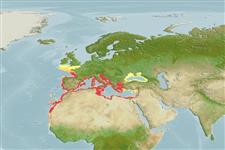>
Eupercaria/misc (Various families in series Eupercaria) >
Sciaenidae (Drums or croakers)
Etymology: Sciaena: Greek, skiaina, skion = a fish, red mullet (Ref. 45335).
More on author: Linnaeus.
Environment: milieu / climate zone / depth range / distribution range
Écologie
marin; saumâtre démersal; profondeur 1 - 200 m (Ref. 9505). Subtropical; 51°N - 13°N, 19°W - 42°E
Eastern Atlantic: Southern Bay of Biscay to Mauritania, occasionally southwards to Senegal. Also throughout the Mediterranean and Black seas. Records from Ghana (Ref. 6810) and Gabon (Ref. 5516) are questionable. Two records in Belgium were actually for Micropogonias undulatus (Linnaeus, 1766) (Ref. 117298). The record off Wimereux is a misinterpretation during data entry mistake from the the Müller (2004, Ref. YYY) (Bailly, pers. comm., March 2018).
Length at first maturity / Taille / Poids / Âge
Maturity: Lm 23.5 range ? - ? cm
Max length : 70.0 cm TL mâle / non sexé; (Ref. 3397); common length : 28.0 cm TL mâle / non sexé; (Ref. 3397); âge max. reporté: 21 années (Ref. 9505)
Description synthétique
Clés d'identification | Morphologie | Morphométrie
Épines dorsales (Total) : 11; Rayons mous dorsaux (Total) : 23 - 25; Épines anales: 2; Rayons mous anaux: 7 - 8.
Occurs in shallow coastal waters mainly on rocky and sandy bottoms, often entering estuaries and more active at night. Also inhabits caves and reefs (Ref. 9987). Feeds on small fishes and crustaceans (Ref. 4780). SCUBA diving observations suggest this to be a very calm fish with remarkable buoyancy control and an ability to move without much apparent effort (Ref. 9505). Marketed fresh and frozen; in Turkey, otoliths are ground to a powder and used as remedy for urinary tract infections (Ref. 9987).
Chao, L.N. and E. Trewavas, 1990. Sciaenidae. p. 813-826. In J.C. Quero, J.C. Hureau, C. Karrer, A. Post and L. Saldanha (eds.) Check-list of the fishes the eastern tropical Atlantic (CLOFETA). JNICT, Lisbon; SEI, Paris; and UNESCO, Paris. Vol. 2. (Ref. 3593)
Statut dans la liste rouge de l'IUCN (Ref. 130435: Version 2024-2)
Menace pour l'homme
Harmless
Utilisations par l'homme
Pêcheries: commercial
Outils
Articles particuliers
Télécharger en XML
Sources Internet
Estimates based on models
Preferred temperature (Ref.
123201): 12.8 - 19.6, mean 15.3 °C (based on 215 cells).
Phylogenetic diversity index (Ref.
82804): PD
50 = 0.5625 [Uniqueness, from 0.5 = low to 2.0 = high].
Bayesian length-weight: a=0.00851 (0.00773 - 0.00937), b=3.08 (3.06 - 3.10), in cm total length, based on LWR estimates for this species (Ref.
93245).
Niveau trophique (Ref.
69278): 3.8 ±0.5 se; based on diet studies.
Résilience (Ref.
120179): Milieu, temps minimum de doublement de population : 1,4 à 4,4 années (K=0.19; tm=3; tmax=21).
Prior r = 0.59, 95% CL = 0.39 - 0.88, Based on 1 data-limited stock assessment.
Fishing Vulnerability (Ref.
59153): Moderate to high vulnerability (46 of 100).
Climate Vulnerability (Ref.
125649): High vulnerability (62 of 100).
Nutrients (Ref.
124155): Calcium = 48 [28, 95] mg/100g; Iron = 0.789 [0.426, 1.386] mg/100g; Protein = 20.1 [18.5, 21.7] %; Omega3 = 0.355 [0.207, 0.554] g/100g; Selenium = 32.5 [16.8, 59.2] μg/100g; VitaminA = 12.4 [4.3, 38.8] μg/100g; Zinc = 0.779 [0.570, 1.144] mg/100g (wet weight); based on
nutrient studies.
